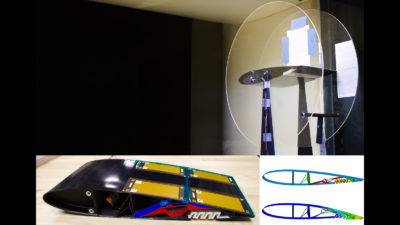Structural dynamicists turn out important lab work despite another year of covid
By Rafael Palacios|December 2021
The Structural Dynamics Technical Committee focuses on the interactions among a host of forces on aircraft, rocket and spacecraft structures.
In January, researchers at the Politecnico di Milano, or POLIMI, in Italy concluded an extended experiment to validate technologies for gust and maneuver load alleviation under European Union Clean Sky 2 funding. This was carried out on a large aeroelastic half model named WTT3, free to move in plunge and pitch, in POLIMI’s 4-by-3.85-meter wind tunnel. The model, originally equipped with primary control surfaces, such as aileron and elevator, demonstrated at vehicle scale an innovative wing tip actuator fully dedicated to gust load alleviation.
With the NASA’s Ingenuity Mars Helicopter making history in April by flying the first powered flight on another planet, larger and more capable rotorcraft are being envisioned for Mars. The unique Martian conditions will likely lead to unusual designs and open a new world for aeroelasticity. NASA’s Jet Propulsion Laboratory and Ames Research Center in California and the University of Maryland are leading that effort, and in a new project, scientists at Ames will design, fabricate and test several concepts, while the University of Maryland will carry out structural design and analysis.
Also in April, researchers at the Faculty of Aerospace Engineering, Technion-Israel Institute of Technology, tested a very flexible wing, known as the Pazy wing, in their wind tunnel. The objective was to explore nonlinear aeroelastic phenomena and provide validation data for the computational community. The Pazy wing is a 100 millimeter chord, 550 mm span rectangular wing made of a core aluminum plate and a 3D-printed nylon chassis. In static wind tunnel tests, the wing deformed to over 50% of its span. In the dynamic tests, researchers documented regions of flutter and limit cycle oscillations instability. Data collection includes displacements and strains collected with a motion tracking system and fiber optic sensors. The results are publicly available and benchmarked by the aeroelasticity community in the third Aeroelastic Prediction Workshop, or AePW, which aims to assess and enhance the state-of-the-art in computational aeroelastic predictions and has drawn international participation across industry, academia and government laboratories. Beyond the large deflection working group, built around the Pazy wing model, the AePW includes the flight test working group to explore the body freedom flutter mechanisms of the X-56A vehicle and the high-angle working group to focus on transonic flutter and shock buffet of the benchmark supercritical wing.
In June, researchers at the University of Washington and POLIMI completed a demonstration of active flutter suppression funded by the FAA. The plan is for the information to be shared with the aeroservoelasticity community to test and analyze novel flutter suppression control methods. The analysis work followed tests, at the POLIMI large wind tunnel, of a swept-wing/T-tail configuration equipped with wing-tip flutter stopper devices for safety. At the University of Washington, researchers carried out additional gust alleviation tests on a wing/fuselage/tail model in the 3-foot-by-3-foot (91-by-91-centimeter) low-speed wind tunnel and an elastic wing with six trailing edge control surfaces in the 12-foot-by-8-foot Kirsten Wind Tunnel. In the low-speed wind tunnel tests, researchers investigated the effects of gust sensing preview on control law design and closed-loop performance, simulating what in full-scale flight will be provided by LIDAR technology. In the Kirsten Wind Tunnel, the team demonstrated active distributed gust alleviation by simultaneous closed-loop actuation of multiple trailing edge flaps.
Contributors: Pawel Chwalowski, Anubhav Datta, Eli Livne, Daniella Raveh, Sergio Ricci and Walt Silva



































